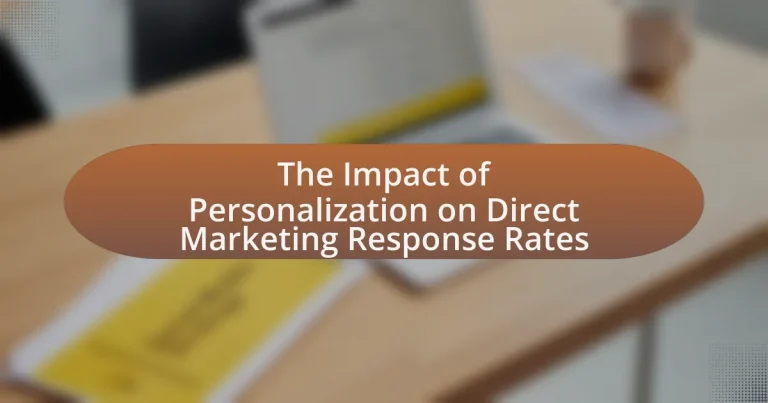The article examines the significant impact of personalization on direct marketing response rates, highlighting that personalized marketing messages can increase response rates by 29% compared to non-personalized ones. It discusses how personalization influences consumer behavior, enhances engagement, and fosters brand loyalty by tailoring marketing strategies to individual preferences and behaviors. Key benefits of implementing personalization, including improved conversion rates and customer retention, are outlined, along with the various types of personalization such as demographic and behavioral. The article also addresses challenges related to data privacy and the importance of compliance with regulations like GDPR, while emphasizing best practices for effective personalization in direct marketing.
What is the Impact of Personalization on Direct Marketing Response Rates?
Personalization significantly enhances direct marketing response rates. Research indicates that personalized marketing messages can lead to a 29% increase in response rates compared to non-personalized messages. This improvement is attributed to the relevance and engagement that personalized content offers to consumers, making them more likely to respond positively. For instance, a study by Epsilon found that 80% of consumers are more likely to make a purchase when brands offer personalized experiences. Thus, the impact of personalization on direct marketing response rates is substantial, driving higher engagement and conversion.
How does personalization influence consumer behavior in direct marketing?
Personalization significantly influences consumer behavior in direct marketing by enhancing engagement and increasing response rates. When marketing messages are tailored to individual preferences and behaviors, consumers are more likely to perceive the content as relevant, leading to higher levels of interaction. For instance, a study by Epsilon found that 80% of consumers are more likely to make a purchase when brands offer personalized experiences. This indicates that personalization not only captures attention but also drives purchasing decisions, ultimately improving the effectiveness of direct marketing campaigns.
What psychological factors are affected by personalized marketing?
Personalized marketing significantly affects psychological factors such as consumer trust, perceived relevance, and emotional engagement. By tailoring messages and offers to individual preferences, brands enhance consumer trust, as personalized interactions signal that the brand understands and values the customer. Research indicates that 80% of consumers are more likely to make a purchase when brands offer personalized experiences, demonstrating the impact of perceived relevance on purchasing behavior. Additionally, emotional engagement is heightened through personalized marketing, as consumers feel a stronger connection to brands that acknowledge their unique needs and preferences. This connection can lead to increased loyalty and repeat purchases, further validating the effectiveness of personalized marketing strategies.
How does personalization enhance customer engagement?
Personalization enhances customer engagement by tailoring experiences and communications to individual preferences and behaviors. This targeted approach increases relevance, making customers feel valued and understood, which in turn fosters stronger emotional connections. Research indicates that personalized marketing can lead to a 20% increase in sales, as customers are more likely to respond positively to offers that resonate with their specific interests and needs. Additionally, a study by Epsilon found that 80% of consumers are more likely to make a purchase when brands offer personalized experiences, demonstrating the effectiveness of personalization in driving engagement and response rates.
Why is personalization important in direct marketing strategies?
Personalization is important in direct marketing strategies because it significantly enhances customer engagement and response rates. Tailoring messages and offers to individual preferences and behaviors leads to a higher likelihood of conversion, as consumers are more inclined to respond to content that resonates with their specific needs. Research indicates that personalized emails can generate six times higher transaction rates compared to non-personalized ones, demonstrating the effectiveness of this approach in driving sales and fostering customer loyalty.
What are the key benefits of implementing personalization?
Implementing personalization significantly enhances customer engagement and conversion rates. Personalized marketing strategies lead to a 20% increase in sales, as evidenced by a study from McKinsey, which found that targeted messaging can improve response rates by up to 10 times compared to generic approaches. Additionally, personalization fosters customer loyalty, with 44% of consumers stating they are likely to become repeat buyers after a personalized shopping experience, according to a report by Epsilon. These benefits demonstrate that personalization not only drives immediate sales but also builds long-term customer relationships.
How does personalization affect brand loyalty and customer retention?
Personalization significantly enhances brand loyalty and customer retention by creating tailored experiences that resonate with individual preferences. When brands utilize data to customize interactions, customers feel valued and understood, which fosters emotional connections. Research indicates that 80% of consumers are more likely to make a purchase when brands offer personalized experiences. Furthermore, personalized marketing can increase customer retention rates by up to 27%, as customers are more inclined to remain loyal to brands that cater to their specific needs and interests. This alignment between customer expectations and brand offerings solidifies loyalty and encourages repeat business.
What are the different types of personalization in direct marketing?
The different types of personalization in direct marketing include demographic personalization, behavioral personalization, geographic personalization, and psychographic personalization. Demographic personalization targets consumers based on characteristics such as age, gender, and income, allowing marketers to tailor messages that resonate with specific groups. Behavioral personalization utilizes data on past consumer behavior, such as purchase history and website interactions, to create customized marketing strategies that enhance engagement. Geographic personalization focuses on the location of consumers, enabling marketers to deliver relevant offers based on regional preferences or local events. Psychographic personalization considers consumers’ lifestyles, interests, and values, allowing for deeper emotional connections through tailored messaging. These personalization types have been shown to significantly improve response rates in direct marketing campaigns, as they create more relevant and engaging experiences for consumers.
How do demographic factors play a role in personalization?
Demographic factors significantly influence personalization by enabling marketers to tailor content and offers to specific audience segments based on characteristics such as age, gender, income, and location. For instance, research indicates that targeted marketing campaigns that consider demographic data can lead to a 20% increase in response rates compared to generic approaches. By analyzing demographic information, businesses can create more relevant messaging, enhancing customer engagement and conversion rates. This targeted approach is supported by studies showing that consumers are more likely to respond positively to marketing that resonates with their demographic profile, thereby validating the importance of demographic factors in effective personalization strategies.
What data is used to create demographic-based personalized marketing?
Demographic-based personalized marketing utilizes data such as age, gender, income level, education, marital status, and geographic location. This data allows marketers to segment audiences effectively and tailor messages that resonate with specific demographic groups. For instance, according to a study by the Direct Marketing Association, targeted marketing campaigns can yield response rates as high as 10 times greater than non-targeted campaigns, demonstrating the effectiveness of using demographic data in personalization strategies.
How effective is demographic personalization compared to other types?
Demographic personalization is highly effective compared to other types of personalization, as it directly targets specific audience segments based on age, gender, income, and location. Research indicates that campaigns utilizing demographic data can achieve response rates up to 50% higher than those using generic messaging. For instance, a study by the Direct Marketing Association found that targeted marketing efforts based on demographic information resulted in a 20% increase in conversion rates compared to non-targeted approaches. This effectiveness stems from the ability of demographic personalization to resonate more deeply with consumers, leading to improved engagement and higher return on investment.
What role does behavioral personalization play in direct marketing?
Behavioral personalization significantly enhances direct marketing by tailoring messages and offers based on individual consumer behaviors and preferences. This targeted approach increases engagement and conversion rates, as consumers are more likely to respond positively to content that resonates with their specific interests. Research indicates that personalized marketing can lead to a 20% increase in sales, demonstrating its effectiveness in driving consumer action. By analyzing data such as past purchases, browsing history, and demographic information, marketers can create highly relevant campaigns that improve customer satisfaction and loyalty.
How is behavioral data collected and analyzed for personalization?
Behavioral data is collected through various methods such as website tracking, mobile app usage, social media interactions, and customer surveys. These methods allow businesses to gather information on user actions, preferences, and engagement patterns.
Once collected, the data is analyzed using techniques like data mining, machine learning algorithms, and statistical analysis to identify trends and insights. For instance, businesses can segment users based on their behavior, enabling targeted marketing strategies that enhance personalization.
Research indicates that personalized marketing can lead to a 20% increase in sales, demonstrating the effectiveness of analyzing behavioral data for tailoring customer experiences.
What are the outcomes of using behavioral personalization strategies?
The outcomes of using behavioral personalization strategies include increased customer engagement, higher conversion rates, and improved customer satisfaction. Behavioral personalization tailors marketing messages based on individual user behavior, leading to more relevant interactions. For instance, a study by McKinsey & Company found that personalized experiences can lead to a 10-15% increase in sales. Additionally, research from Epsilon indicates that 80% of consumers are more likely to make a purchase when brands offer personalized experiences. These statistics demonstrate the effectiveness of behavioral personalization in enhancing marketing response rates.
What challenges are associated with personalization in direct marketing?
Challenges associated with personalization in direct marketing include data privacy concerns, the complexity of data integration, and the risk of over-segmentation. Data privacy concerns arise from regulations like GDPR, which restrict how consumer data can be collected and used, potentially limiting the effectiveness of personalized campaigns. The complexity of data integration involves combining data from various sources, which can be technically challenging and resource-intensive, leading to inconsistencies and inaccuracies in targeting. Over-segmentation can result in marketing messages becoming too niche, alienating broader audiences and reducing overall campaign effectiveness. These challenges highlight the need for careful strategy and compliance in implementing personalization in direct marketing.
What privacy concerns arise from personalized marketing efforts?
Personalized marketing efforts raise significant privacy concerns, primarily related to data collection and user consent. Companies often gather extensive personal information, including browsing habits and purchase history, which can lead to unauthorized use or data breaches. According to a 2021 survey by the Pew Research Center, 79% of Americans expressed concern about how their data is being used by companies, highlighting the widespread unease regarding privacy in personalized marketing. Additionally, the General Data Protection Regulation (GDPR) mandates that businesses obtain explicit consent from users before processing their personal data, emphasizing the legal implications of failing to address privacy concerns adequately.
How can marketers address consumer privacy concerns effectively?
Marketers can address consumer privacy concerns effectively by implementing transparent data practices and obtaining explicit consent from consumers. Transparency involves clearly communicating how consumer data will be used, which builds trust and reduces anxiety about privacy. According to a 2021 survey by the Pew Research Center, 79% of Americans expressed concern about how their data is being used by companies, highlighting the importance of addressing these concerns directly. Additionally, marketers should adopt privacy-focused technologies, such as data anonymization and encryption, to protect consumer information. By prioritizing consumer privacy, marketers can enhance their credibility and improve engagement rates in personalized marketing efforts.
What regulations impact the use of personalization in marketing?
Regulations that impact the use of personalization in marketing include the General Data Protection Regulation (GDPR) in the European Union and the California Consumer Privacy Act (CCPA) in the United States. GDPR mandates that businesses obtain explicit consent from consumers before collecting and processing their personal data, which directly affects how marketers personalize their campaigns. Similarly, CCPA grants California residents the right to know what personal data is being collected and the ability to opt-out of its sale, influencing the extent to which companies can tailor their marketing efforts. These regulations aim to protect consumer privacy and ensure transparency in data usage, thereby shaping the strategies marketers employ for personalization.
How can businesses measure the effectiveness of personalization?
Businesses can measure the effectiveness of personalization through key performance indicators (KPIs) such as conversion rates, customer engagement metrics, and customer retention rates. By analyzing conversion rates, businesses can determine how many personalized interactions lead to desired actions, such as purchases or sign-ups. Customer engagement metrics, including click-through rates and time spent on personalized content, provide insights into how well the personalization resonates with the audience. Additionally, tracking customer retention rates helps assess the long-term impact of personalization on customer loyalty. Research indicates that personalized marketing can lead to a 20% increase in sales, highlighting its effectiveness in driving business outcomes.
What metrics are most relevant for assessing response rates?
The most relevant metrics for assessing response rates include the response rate percentage, conversion rate, and engagement metrics. The response rate percentage quantifies the proportion of recipients who take the desired action, providing a direct measure of campaign effectiveness. The conversion rate further refines this by indicating the percentage of respondents who complete a specific goal, such as making a purchase. Engagement metrics, such as click-through rates and open rates, offer insights into how well the audience interacts with the marketing material, which can influence overall response rates. These metrics collectively provide a comprehensive view of the effectiveness of direct marketing efforts, particularly in the context of personalization strategies that aim to enhance engagement and response.
How can A/B testing be utilized to evaluate personalized campaigns?
A/B testing can be utilized to evaluate personalized campaigns by comparing the performance of two variations of a campaign, one personalized and one standard. This method allows marketers to measure key performance indicators such as conversion rates, click-through rates, and engagement levels between the two groups. For instance, a study by Google found that personalized email campaigns can lead to a 29% higher open rate compared to non-personalized ones, demonstrating the effectiveness of personalization. By analyzing the results from A/B testing, marketers can determine which personalized elements resonate most with their audience, thereby optimizing future campaigns for better response rates.
What best practices should be followed for effective personalization in direct marketing?
Effective personalization in direct marketing requires leveraging customer data to tailor messages and offers to individual preferences and behaviors. Utilizing data analytics allows marketers to segment audiences based on demographics, purchase history, and engagement levels, ensuring that communications resonate with specific groups. For instance, a study by McKinsey & Company found that personalized marketing can lead to a 10-30% increase in sales, highlighting the importance of targeted messaging. Additionally, employing dynamic content in emails and advertisements enhances relevance, as it adjusts based on user interactions. This approach not only improves customer experience but also boosts response rates, as evidenced by research from Epsilon, which indicates that 80% of consumers are more likely to make a purchase when brands offer personalized experiences.
How can businesses segment their audience for better personalization?
Businesses can segment their audience for better personalization by utilizing demographic, psychographic, behavioral, and geographic data. This approach allows companies to tailor their marketing strategies to specific audience segments, enhancing engagement and response rates. For instance, a study by McKinsey & Company found that personalized marketing can lead to a 10-30% increase in response rates, demonstrating the effectiveness of targeted segmentation. By analyzing customer data, businesses can identify distinct groups based on characteristics such as age, interests, purchasing behavior, and location, enabling them to create more relevant and appealing marketing messages.
What tools and technologies can enhance personalization efforts?
Tools and technologies that can enhance personalization efforts include customer relationship management (CRM) systems, data analytics platforms, and artificial intelligence (AI) algorithms. CRM systems, such as Salesforce, enable businesses to collect and analyze customer data, allowing for tailored marketing strategies. Data analytics platforms, like Google Analytics, provide insights into customer behavior and preferences, facilitating targeted campaigns. AI algorithms, including machine learning models, can predict customer needs and automate personalized content delivery, significantly improving engagement. According to a study by Epsilon, 80% of consumers are more likely to make a purchase when brands offer personalized experiences, underscoring the effectiveness of these tools in enhancing personalization efforts.















